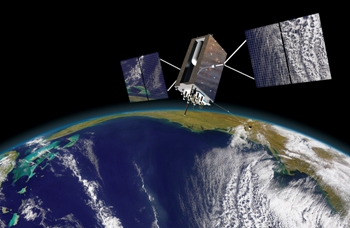Lockheed Martin has completed and is preparing to install the navigation, communication, and hosted payload antenna assemblies for the first satellite of the next generation Global Positioning System, known as GPS III.
 GPS III satellite
GPS III satellite
Seven antenna assemblies, produced at Lockheed Martin’s Newtown, Pa. facility were delivered to the company’s GPS III Processing Facility (GPF) near Denver, Colo. on June 14. The antennas will be installed on the first GPS III space vehicle (SV 01), which Lockheed Martin will deliver to the U.S. Air Force on schedule, “flight-ready,” in 2014.
The new antennas for GPS III SV 01 will provide the satellite’s capability to send and/or receive data for earth-coverage and military earth-coverage navigation; a UHF crosslink for inter-satellite data transfer; telemetry, tracking and control for satellite-ground communications; and data acquisition and communication for the nuclear detection system hosted payload. The antenna designs enable three to eight times greater anti-jamming signal power to be broadcast to military users across the globe when compared to previous GPS generations.
“These antennas on the next generation of GPS III satellites will transmit data utilized by more than one billion users with navigation, positioning and timing needs,” explained Keoki Jackson, vice president of Lockheed Martin’s Navigation Systems mission area. “We have become reliant on GPS for providing signals that affect everything from cell phones and wristwatches, to shipping containers and commercial air traffic, to ATMs and financial transactions worldwide.”
GPS III is a critically important program for the Air Force, affordably replacing aging GPS satellites in orbit, while improving capability to meet the evolving demands of military, commercial and civilian users. GPS III satellites will deliver three times better accuracy, include enhancements which extend spacecraft life 25 percent further than the prior GPS block, and a new civil signal designed to be interoperable with international global navigation satellite systems.
The production of the first GPS III satellite continues on schedule. Recent testing of the SV 01 bus – the portion of the space vehicle that carries mission payloads and hosts them in orbit – assured that all bus subsystems are functioning normally and that they are ready for final integration with the satellite’s navigation payload.
This milestone follows February’s successful initial power on of the SV 01 spacecraft bus, which demonstrated the electrical-mechanical integration, validated the satellite’s interfaces and led the way for functional electrical hardware-software integration testing.
Lockheed Martin is currently under contract for production of the first four GPS III satellites (SV 01-04), and has received advanced procurement funding for long-lead components for the fifth, sixth, seventh and eighth satellites (SV 05-08).
The GPS III team is led by the Global Positioning Systems Directorate at the U.S. Air Force Space and Missile Systems Center. Lockheed Martin is the GPS III prime contractor with teammates ITT Exelis, General Dynamics, Infinity Systems Engineering, Honeywell, ATK and other subcontractors. Air Force Space Command’s 2nd Space Operations Squadron (2SOPS), based at Schriever Air Force Base, Colo., manages and operates the GPS constellation for both civil and military users.
Headquartered in Bethesda, Md., Lockheed Martin is a global security and aerospace company that employs about 118,000 people worldwide and is principally engaged in the research, design, development, manufacture, integration, and sustainment of advanced technology systems, products, and services. The Corporation’s net sales for 2012 were $47.2 billion.